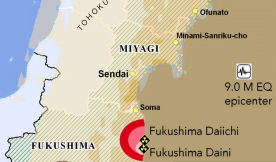The UN Office for the Coordination of Humanitarian Affairs (OCHA) is a reliable source of information about the earthquake and Tsunami that rocked Japan last week.
Here are some highlights from their latest update:
Casualties:
The Government has officially reported that 3,100 people in 12 prefectures have died and another 3,118 people in five different provinces are missing. Another 1,885 are injured. Minami Sannriku town in Miyagi prefecture and Otsuchi town in Iwate prefectures are the most affected areas with an estimated 20,000 people – half of the population – still out of contact as of 15 March. In addition, more than 1,000 bodies have been found in the coastal area of Onagawa town in Miyagi.
Structural Damage:
As of 15 March, 3,385 buildings are destroyed and over 55,000 damaged either by earthquakes, tsunami or fire. Transportation systems still remain paralyzed but the Government is making significant progress to restore key roads, bridges and railways. The National Police Agency says at least 128 roads and 21 bridges damaged by the earthquake and tsunami have been repaired. Essential services such as
electricity, gas and water remain disrupted, with more than 843,000 households serviced by Tokyo Electric Power Company and Tohoku Electric Power Company experiencing power shortages. Some 1.4 million households still remain without water.
Government Response:
The Government has deployed 100,000 troops to lead the relief effort. With the help of 9,500 fire-fighters and 920 police they have together rescued 22,184 people to date. In Miyagi, one of the most affected prefectures, which sustained the largest number of casualties and the largest number of evacuees, the National Police Agency and Japan Self-Defence Force have rescued more than 2,200 people to date. It has rescued stranded people and sick patients. In addition, the Japan Coast Guard, and Fire and Disaster Management Agency have rescued nearly 3,000 people.
International Response:

